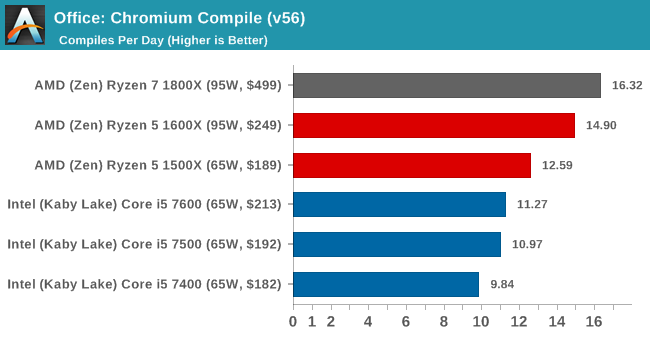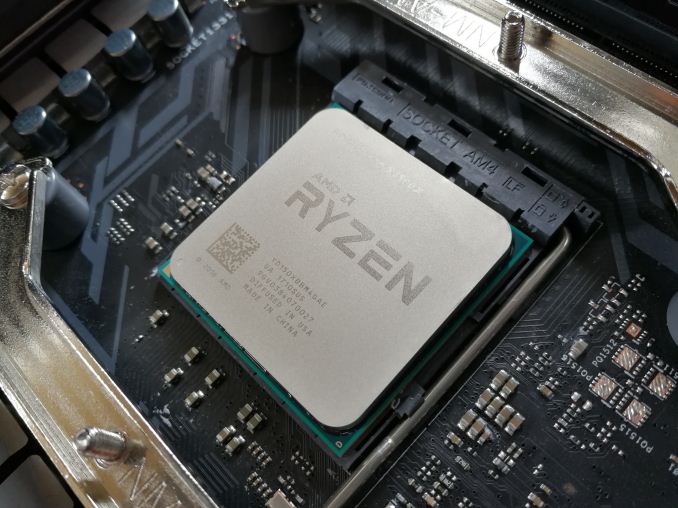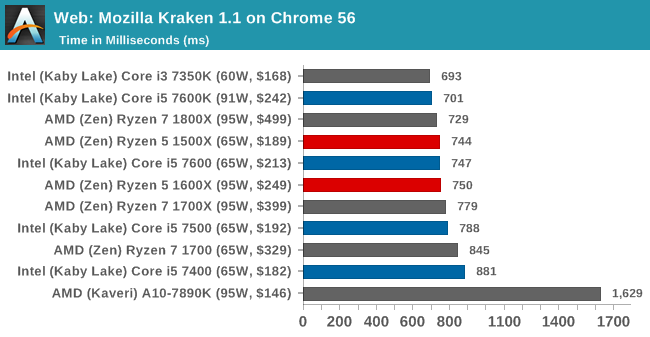The AMD Ryzen 5 1600X vs Core i5 Review: Twelve Threads vs Four at $250
by Ian Cutress on April 11, 2017 9:00 AM ESTAMD Ryzen 5
We mentioned at the top of the review that AMD’s Ryzen 7 launch last month benefited in a market where the competition was extremely expensive – being able to offer equivalent performance in most tasks and then undercut the competition by 50% is a difficult task, but the opening was always there due to a lack of competition in this space. When it comes to the mainstream market, the Ryzen 5 processors are actually competing on price with Intel’s processors directly, and thus has to offer something more to compete.
We have already shown in previous reviews that the Zen microarchitecture from AMD is around the equivalent of Intel’s Broadwell microarchitecture, but at this lower price point we have AMD’s Zen against Intel’s Kaby Lake, which is two generations newer than Broadwell and affords a comfortable IPC uplift over Broadwell. Given AMD’s monolithic design strategy of a single silicon die catering for most of their product line (well, all of it so far), the way AMD is tackling this is through more cores.
Before the debate about cores from AMD’s past rears its head (Vishera/Bulldozer designs in that case), given that AMD’s single thread performance is not too far behind, having a big set of cores as an alternative is something interesting for end-users, especially as more work flows and gaming titles rely on multithreading to scale. As a result, where Intel offer four cores and four threads, AMD is now offering six cores and twelve threads – a potential +200% uptick in the number of threads and +50% in cores, albeit at 10-15% lower instructions per clock.
(There’s also a side argument here about die sizes and wafer costs to each company to consider, but we will leave that for a different piece.)
For this review, based on time and available parts, we tested the Ryzen 5 1600X six-core processor against a set of Intel Core i5 parts that users might also be considering. We have some Ryzen 5 1500X quad-core numbers in here as well, and that might be spun out into a separate review at a later date. We also demonstrated our new 2017 CPU gaming tests, with four GPUs, six tests, two resolutions per test, and a couple of extra extreme resolution tests.
On The Benchmark Results
Looking at the results, it’s hard to notice the effect that 12 threads has on multithreaded CPU tests. The usual culprits show big wins for AMD here: 2D to 3D photo conversion, ray tracing, Blender, Cinebench, Encryption and video transcoding are all sizable wins. This is the sort of workload in which moving up to the Ryzen 7 CPUs, budget permitting, also do well on.
A new test in our suite for this review is a Compile Chromium test on Windows. As part of our testing suite, we have a fixed nightly download from mid-March and set this to compile, taking the final time and converting it into how many compiles per day. For around $250, Ryzen is the only way to go:

As you would expect, AMD still lags in IPC to Intel, so a 4.0 GHz AMD chip can somewhat compete in single threaded tests when the Intel CPU is around 3.5-3.6 GHz, and the single thread web tests/Cinebench results show that.
On The Gaming
Our gaming tests are a mix of Full-HD and 4K testing, some of which ends up being more CPU limited than we expected.
Civilization, at both 1080p and 4K Ultra settings, seem to scale quite happily with more cores on all GPUs, except the GTX 1060 at 4K. It’s worth noting situations such as the R9 Fury at 1080p Ultra only has 920ms under 60 FPS on the 1600X, compared to 6300 milliseconds on the Core i5-7600.
Shadow of Mordor leans towards the higher IPC of Intel, as the DX11 title cannot take advantage of the cores as much. Rise of the Tomb Raider’s benchmark is notorious for having each of its three seconds perform differently with respect to CPU scaling, with the Prophets scene being more CPU limited than the rest of the stage in the game.
Rocket League using an AMD CPU + AMD GPU actually provides more equal results with NVIDIA GPUs, however there's a performance drop using Ryzen + NVIDIA, which potentially correlates towards a driver bug but we're not 100% sure what is going on. Grand Theft Auto is a mixed bag, despite being a DX11 title – in some situations the Ryzen 5 is ahead of the Intel CPUs, or they all perform about the same, or the Intel CPUs pull ahead.
I have $250, What Should I Get – the Core i5 7600/7600K or the Ryzen 5 1600X?
Platform wise, the Intel side can offer more features on Z270 over AM4, however AMD would point to the lower platform cost of B350 that could be invested elsewhere in a system.
On performance, for anyone wanting to do intense CPU work, the Ryzen gets a nod here. Twelve threads are hard to miss at this price point. For more punchy work, you need a high frequency i5 to take advantage of the IPC differences that Intel has.
For gaming, our DX12 titles show a plus for AMD in any CPU limited scenario, such as Civilization or Rise of the Tomb Raider in certain scenes. For e-Sports, and most games based on DX9 or DX11, the Intel CPU is still a win here.












254 Comments
View All Comments
Meteor2 - Wednesday, April 12, 2017 - link
I think exact the same thing: R5 1600 + RX580 is going to be unbeatable value for money.deltaFx2 - Tuesday, April 11, 2017 - link
@Ian Cutress: It would be helpful to know whether any of the workloads above use AVX-256, just to know how prevalent they are in common code. For example, does your 3DPM code use AVX-256? Also, when you run legacy tests, are the binaries legacy too, or do you recompile when applicable?beerandcandy - Wednesday, April 12, 2017 - link
This looks like it might be a good start for AMD to get back in the game. This isn't the normal way you try to do these things. I think mostly you want to show your best CPU "DESTROY" the competitors best CPU. If AMD doesn't do that then it sucks because they wont be able to compete in the halo CPU product areas. This will also cause them to be in a limited market space and they will be forced into less profitable situationspandemonium - Wednesday, April 12, 2017 - link
I am curious why comparable Intel 2011-3 CPUs weren't included? The i7-6800k would be in nearly direct competition to the 1800X based on cores and MSRP.ET - Wednesday, April 12, 2017 - link
Thanks for the comprehensive testing. I was missing some Core i7 results for comparison in some tests, such as the compilation test.Lechelou - Wednesday, April 12, 2017 - link
Leonard Nimoy voiced Civ IV, not V. Just sayin'.madwolfchin - Wednesday, April 12, 2017 - link
Someone at AMD should rethink about the position of R7 1700 vs R5 1600X, The 1600X is faster in Single Tread, and about even with the 1700 in multi-threaded application. Why would anyone buy the 1700 which is much more expensiveOutlander_04 - Wednesday, April 12, 2017 - link
Because you can OC it and have the same performance as an 1800XMeteor2 - Wednesday, April 12, 2017 - link
I've only read as far as the test-bed set-up page: I want to say a MASSIVE thank you to MSI for supplying the GTX1080s. Top stuff, and that won't be forgotten.Back to reading...
vladx - Wednesday, April 12, 2017 - link
Wow so Anandtech have now turned into AMD shills. Not only you conveniently excluded or ignored the 7700k, but also skipped the 7600k from the gaming benchmarks to paint Ryzen in a better light than reality actually reflects.I understand you had to finish the article ASAP but Anandtech was all about quality articles and you really should've published the article when you had all the facts.